Why us?
HPLC – Why us, not big brands? Agilent/Shimadzu/Waters
| CTInstruments HPLC | Shimadzu Cannabis Potency Analyzer | Agilent 1220 Infinity II LC System | |
|---|---|---|---|
| # of cannabinoids | 13 | 11 | 11 |
| # of terpenes | 28 | none | none |
| Type of sample tested | any | any | any |
| # of samples per 8 hours | 36 | 48 | 48 |
| Autosampler | available | standard | standard |
| Accuracy | high | high | high |
| Ease of use | beginner | advanced user | advanced user |
| Type of instrument | commercial | commercial | commercial |
| Cannabis industry expertise | excellent | excellent | excellent |
| Price | $ | $$$ | $$$ |
Wondering why you would buy an affordable HPLC? Is there something wrong? Why does Shimadzu HPLC for testing cannabinoids cost $65,000?
These are legitimate questions. There is nothing wrong with our HPLC and yes, it is a proper HPLC. Companies like Shimadzu, Agilent, Waters have been manufacturing HPLCs for decades. In order to stay competitive in the industry, they have been investing in R&D to develop more sophisticated instruments. Their target customers are R&D organizations, universities, and commercial laboratories. Each of these has different needs, which are typically covered by 1 very capable instrument. Historically, HPLCs started with a simple single reciprocating pump. With a growing need for capabilities, these companies at the forefront of HPLC development designed binary and quarternary pumps to give their customers the ability to mix multiple solvents during the analysis, run gradients – this gives universities more freedom to do R&D and commercial labs freedom to expand the number of tests they can carry out for their clients. Further, commercial labs have an unsatiated need for doing analyses faster to reduce cost per analysis and increase capacity. This can physically be done by shortening the length of the column and packing it with finer powder to shorten the time of analysis and increase interaction between the column and the analyte to still afford the desired separation on a shorter column. This comes at the expense of significant pressure increases in order to push the mobile phase through a more tightly packed column – hence, companies developed pumps and systems running at higher pressures in order to satisfy the needs of commercial labs. On top of these developments, both R&D companies/universities and commercial labs had further needs to expand the capabilities to separate and analyze chemicals leading to the development of more diverse and sophisticated detectors, degassing systems, and many other bells and whistles.
As a result of all this, companies like Shimadzu basically re-branded their high-performance HPLCs, developed cannabinoids testing methods and started selling these powerful instruments to the cannabis community.
So where do we stand in all this? We have decided to go the opposite direction by simplifying the design, going back to a reciprocating pump, using a simple UV detector.
We use exactly the same columns as Shimadzu or Agilent do, we don’t use binary/quaternary pump, i.e. mobile phase gradient, but rather pre-mix a simple mobile phase prior to analysis and run it in an isocratic mode. We don’t use a DAD or PDA detector capable of analyzing multiple wavelengths, we instead use a simple UV detector analyzing cannabinoids at a single wavelength. None of the bells and whistles sold by larger companies are needed – cannabinoids are analyzed at a single wavelength regardless of how capable the detector is, cannabinoids can be analyzed using an isocratic mode, hence there is no need for a binary/quaternary pump. The analysis can be done on a 150mm column, rather than a shorter and more packed column, eliminating the need for ultra-high pressures.
As a result of this, we are able to shave off $50,000 from the price of the instrument that is still well-built and suitable for analysis of cannabinoids. The only 2 major differences from the perspective of the person doing the analyses is that you have to manually pre-mix a simple mobile phase consisting of 2 solvents (just mixing 2 bottles together) and our method runs for 13.2 minutes, rather than ultra-high pressure HPLCs doing the same analysis in 8 minutes. Although, this being said, we are able to shorten the analysis time to around 8 minutes as well.
Our system is infinitely less complex, much easier to use and maintain due to the lack of ultra-high pressures. Our system operates at around 800 psi. It is, just like any other HPLC suitable for many other tests and includes proper HPLC software for more adventurous customers looking to expand the use of our HPLC for testing other things, not only cannabinoids.
Our goal is to make the cannabis HPLC analyzer accessible financially and to be simple to use by anyone without any chemistry background.
Why us and not second-hand (used) Agilent/Shimadzu/Waters HPLC?
The second-hand/used HPLC market is well functioning and you can get a used, older HPLC for $8,000 – $15,000. The issue is that just like a car, the parts, such as pump seals, rods, pistons are worn, especially if operating at high pressures. You are running a risk of increased additional costs and shut downs due to maintenance. You also should be prepared to learn how to disassemble and assemble pumps, high pressure lines, change detector lamps.
Our HPLC is new at the same price.
Furthermore, at $15,990 we include HPLC software, calibration curves, developed and validated cannabinoids testing methods, reporting system, SOPs. You don`t have to spend months and thousands of dollars on method development and validation.
Why us and not Lightlab from Orange Photonics?
Many of our customers consider purchasing Orange Photonics instrument as it is in the same price range. Lightlab instruments from Orange photonics are not HPLCs. They use so-called solid phase extraction or flash chromatography cartridges. These are made from polypropylene and are designed to be used in low pressure applications (typically max. 50psi) and are typically disposable. They usually cost around $5/pc. By design, the LightLab instrument pushes larger volumes of solvent through this cartridge to separate cannabinoids. While the claims of Orange Photonics are admirable, it is questionable you can separate the many claimed cannabinoids on a low pressure, short, disposable cartridge in 8 minutes. For comparison, we get excellent separation of cananbinoids on a 150mm, much more finely packed stainless steel column running at pressures of around 800psi.
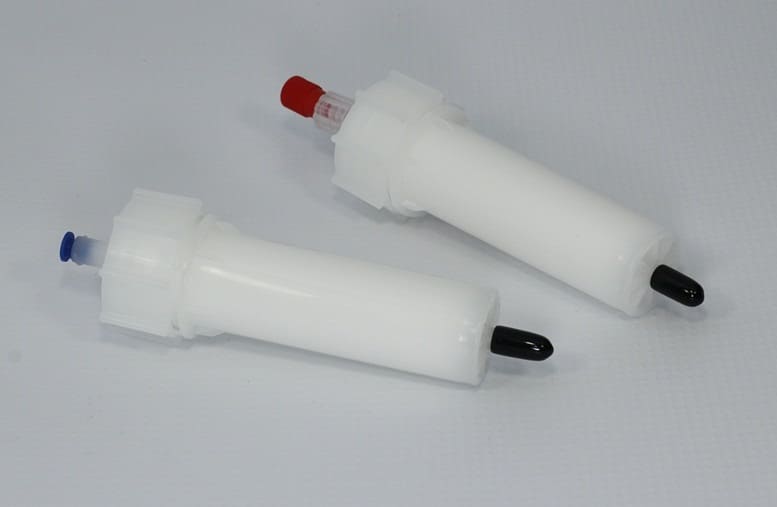
vs.
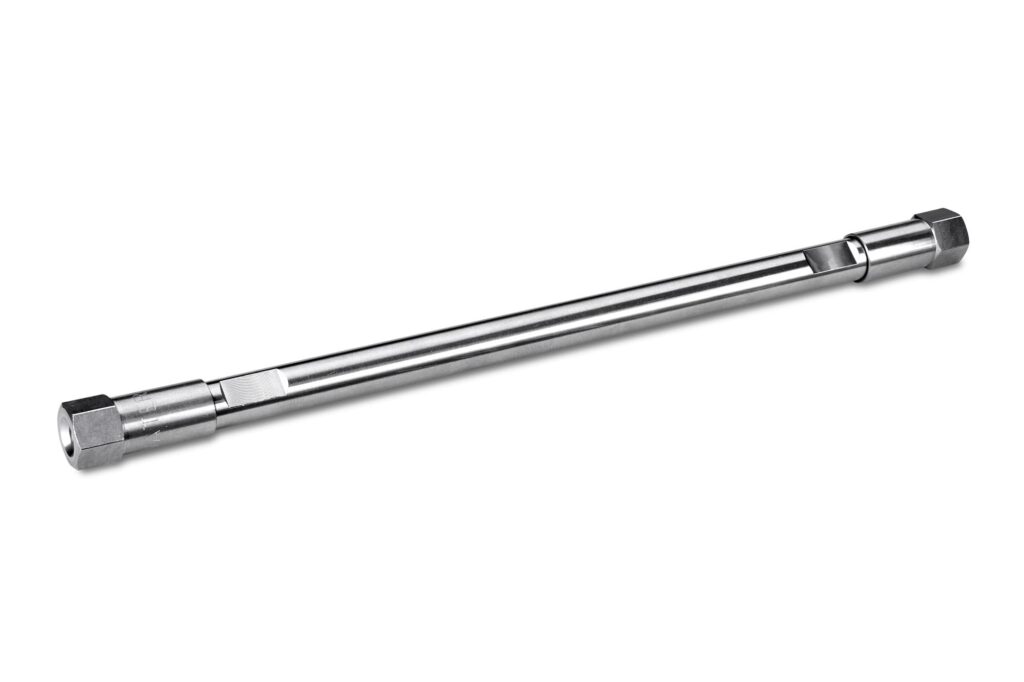
One of the first things we get asked by those having experience with HPLCs is if we control column temperature. The impact of temperature on retention times and peak shape is well established in chromatography. We found that there is ca. 7% difference in measured peak height of d9-THC when running the analysis at 40C as opposed to 30C. Our HPLC has a temperature-controlled column compartment to assure the analysis is consistently run at the same temperature every time. Furthermore, we use precision analytical balances, calibrated glass microsyringes, calibrated glass volumetric pipets to assure accuracy and repeatability.
To compare with the aforementioned cartridges, our column lasts around 3,000 injections. The total cost of analysis on our system is around $5/test. We don`t sell you any modules, cannabinoids are the same whether they are in cannabis, hemp plant, or extracts. The same scientific principles apply and we have only 1 method that separates and measures cannabinoids accurately.
We don`t sell a black-box that shows numbers; while we have automated the peak recognition and concentration quantification, our HPLC includes a proper HPLC software – you see live analysis as you would see with any other HPLC and have the ability to further refine the analysis should you decide to do so.
Why us and not NIR (Near Infra Red) analyzers? Purple Pro/GemmaCert/Sage
Two words – the wrong technology. While the ambition of these companies is admirable, the technology (in our opinion) does not allow for accurate measurement of cannabinoids. Each of these instruments claims to measure cannabinoids in flower. Just like every light-based analytical technique, NIR requires light passing through the sample. NIR is known for its poor selectivity, and the impact of particle size and packing density on the measurement due to issues caused by light passing through the sample. In general, infrared measurements are not done on solid samples in the way these NIR analyzers do. Furthermore, NIR is particularly useless in the presence of water, as water shows as wide bands covering other peaks in its region. The above-mentioned companies claim to try to use artificial intelligence to overcome apparent shortcomings of this technology, which are based on physics limitations. In simple terms, these companies are claiming to “harness the power of AI/machine learning” where in reality, the technology is not capable to do a direct measurement of cannabinoids, but rather use algorithms to infer the results. In comparison, HPLCs do proper direct measurement. As the technology does not separate cannabinoids, but rather tries to measure them in a complex matrix, the ability to match the spectrum to various cannabinoids is not reliable.
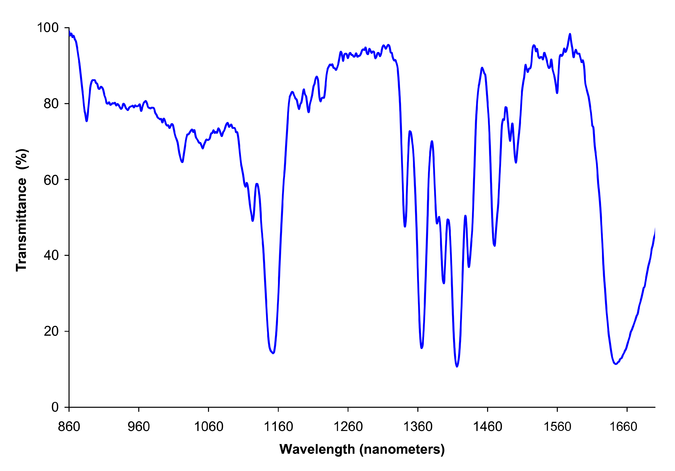
Water band in NIR
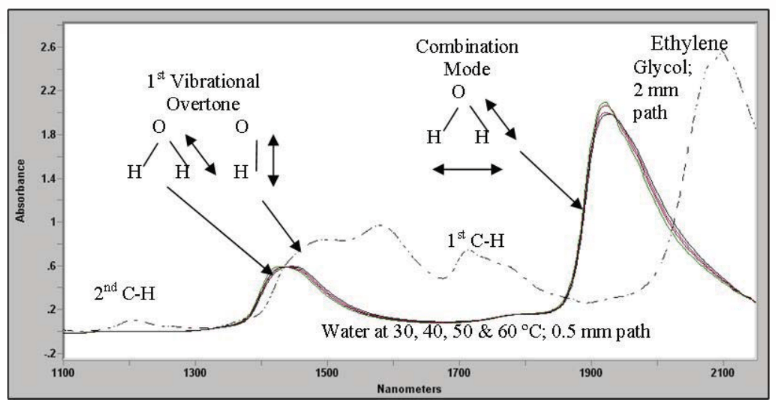
Why us and not fluorescene analyzers? FluroTech
FluroTech has come out with an analyzer based on fluorescence spectrometry. The physics behind fluorometry is very cool. It is based on the principle that some chemicals have the ability to absorb light at a certain wavelength (excitation wavelength) and then release energy in the form of fluorescence at a very specific wavelength (emission wavelength). The principle is the same as phosphorescence you see in gadgets/watches coated with phosphorus, with the difference being that phosphorescence lasts hours while fluorescence only a fraction of a second. The combination of excitation and the emission wavelength is very unique to a specific chemical and allows finding the said chemical in a complex cocktail of other chemicals. In addition, fluorescence as a technique is significantly more sensitive than UV measurements used in HPLC (including ours). This is where the awesomeness of fluorometry ends for cannabinoids, unfortunately. The issue with fluorescence is that it produces very broad peaks as the phenomenon is relatively long-lived – this results in a complete inability to separate and quantify chemicals from the same class; hence tough luck for a class of cannabinoids.
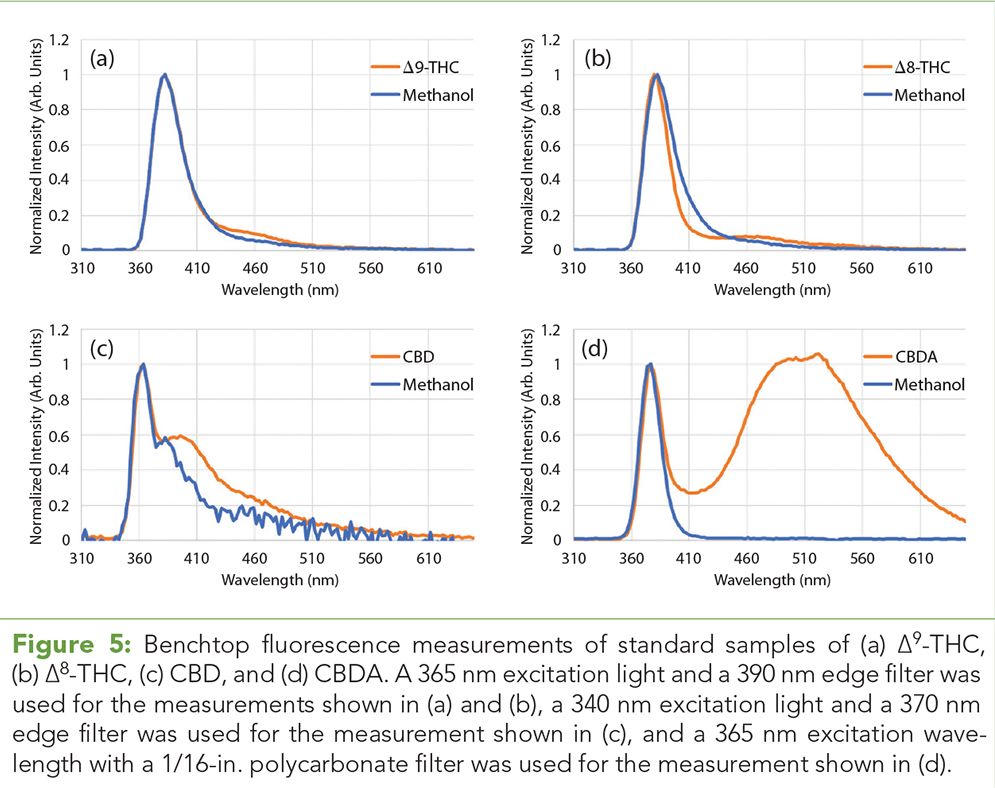
Why us not UV analyzers? tCheck
You can find low-cost, simple UV analyzers, such as tCheck, for around $300. The way they work is they measure UV absorbance of the sample – very much so as our HPLC with a UV detector. The issue is that the HPLC separates cannabinoid mixture in the sample into individual cannabinoids, while simple UV analyzers don`t. As a result, they are not able to distinguish between different cannabinoids and measure all cannabinoids together as 1 value – in other words, as all cannabinoids bunched into 1 peak. Cannabinoids absorb light at 220nm and do so at varying intensity – i.e. CBN absorbs UV at 220nm ca. 50% more than THC, while THCA ca. 30% less than THC. Having a combination of cannabinoids, while measuring all as 1 value results in significant distortion of results. Below is an image of tCheck accuracy as an example (taken from tCheck website), where for instance HPLC measured 22.5% THC is measured anywhere from 16% to 25.5% THC using tCheck.

As you can see, we are opinionated. This stems from years of research using each of the above technologies extensively.
Any questions, give us a shout-out via twitter, IG, or message us via whatsapp +19414678386.
